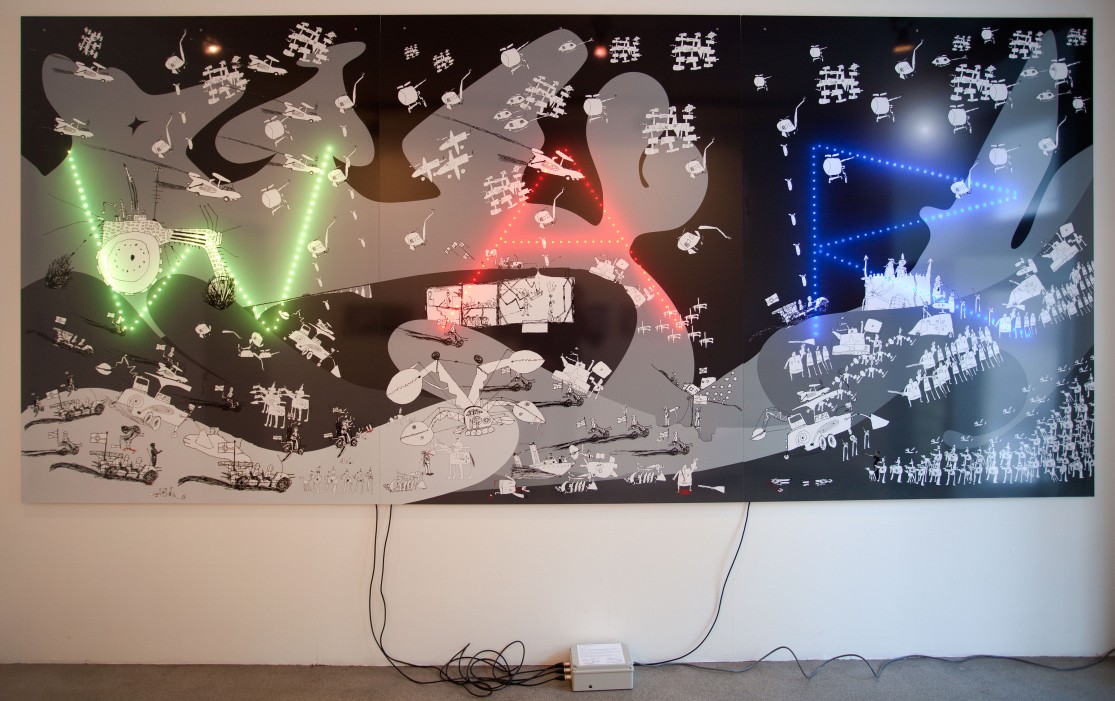Å–gallery, Turku, Finland 8.12. – 30.12.2012
An underlying theme in many of Jan-Erik Andersson’s art projects is the exploration and questioning of the borderline between the adult world and the childhood. Andersson’s most known work, the leaf shaped Life on a Leaf house project (with architect Erkki Pitkäranta) is, among other things, also an investigation in why a building based on iconic shapes and humour is usually excluded from “serious” architecture and placed into the realm of the Disney world, which is regarded belonging to a “lower level”. Many of Andersson’s colourful and expressive environmental projects bring him in a constant struggle with the late modernist city planning in Finland.
When he was invited to do a solo exhibition in the Turku Artists’ association’s small gallery he got a chance to step out from the struggles in the pubic art sphere and go more deeply into the realm of personal memories. As a theme he chose guns and war, which has been in a current interest because of Andersson’s now eight years old son, Adrian. Long before he turned two he built a gun out of a garlic press and a sushi-stick (seen as a reconstruction in the exhibition). Some years later a mass of drawings filled with war scenes and guns appeared. This gave Andersson a reason to search for his own childhood drawings, made when he was in the same age, which as well, were full of the same kind of violence. By scanning and vectorizing the drawings an epic drawing project was born; a battle between the troops of the father and the troops of the son. By tracing and redrawing many of the lines on his childhood drawings in the creation of the art print, he also got in touch with the dream of many artists to find the spontaneous line of the childhood.
The print is mounted on three sheets of acrylate, which are fastened closely together. Behind each of the sheets, strips of RGB LED lights are fastened which form the word WAR. The letters are flashing randomly in different colours, controlled by a computer system.
Even if the exhibition offers reason to speculate if war is the result of ”the human nature” or if it is born out of societal circumstances, the main theme of the exhibition is the communication between the generations. Are we able to through play, care taking and love to crack the paths on which violence is transferred from generation to generation?
The artwork also relates to the great amount of works depicting war, from cave drawings to Guernica. But it also brings to mind artists who work with their children. Also in Andersson’s earlier production there are works, which deal with the generation theme. His daughter Li painted details for installations and many plaster cast of her were used for public sculptures.
The exhibition also includes a sculptural installation on the floor; a Glock gun and two bullets made of concrete and cast in earth moulds. On the concrete surface traces and imprints of leaves, stones and branches can be seen. Exhibition visitors are allowed walk on the gun. A series of Chromaluxe photographic prints of the Earth gun taken during different seasons is shown on the gallery wall.
In the cellar room of the gallery Andersson showed the installation The Destruction of Beauty, which through a video, originally published on YouTube, shows the tearing down of the Blue House, an iconic Turku Art Nouveau building, in 2011, when Turku was the Cultural capital of Europe. The video stresses the importance of the mental space ornate buildings create in the urban environment. The monitor is placed on a wooden part of the original ornamentation of the house, saved from the demolition process.
A war is taking place on different levels all the time.













